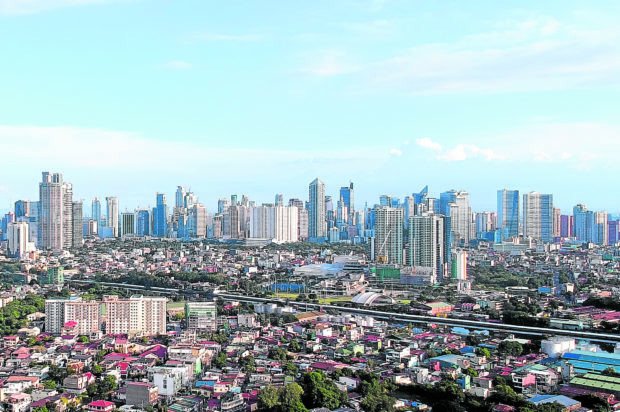
The Makati skyline. (File photo by GRIG C. MONTEGRANDE / Philippine Daily Inquirer)
MANILA, Philippines — The Philippine economy likely withstood the Omicron surge at the start of this year and sustained growth during the first quarter — estimated by economists to range from 5.5 percent to as high as 8.3 percent year-on-year.
Beyond the possibly strong end-March gross domestic product (GDP) performance, which the government will report on May 12, economists watching the Philippines flagged high debts and a yawning budget deficit, elevated inflation that could temper consumer spending, as well as some excess baggage carried by leading presidential candidates who may win the elections, which could slow down the Philippines’ flight to economic recovery this year. (See related story on page A3)
On Sunday, Socioeconomic Planning Secretary Karl Kendrick Chua said in a statement that the Philippine economy “will return to its prepandemic growth this year as the country continues to build on progress in recovering from COVID-19 from the first half of the administration.”
Chua, who heads the state planning agency National Economic and Development Authority (Neda), declined to say if the first-quarter output likely already reverted to pre-COVID-19 levels, pending the official Philippine Statistics Authority (PSA) report.
Soaring commodity prices
Of the 18 first-quarter GDP growth forecasts collected by the Inquirer last week, Bank of the Philippine Islands’ Emilio Neri Jr. had the highest estimate of 8.3 percent.
But Neri said the “trade shock and destructive effects of soaring commodity prices on overall demand”—wrought by Russia’s invasion of Ukraine—tempered his growth expectation for full-year 2022 to 6 to 6.5 percent from 7 to 7.5 percent previously, especially if oil prices remained close to $100 per barrel.
Economic reopening
The government targets 7 to 9 percent GDP expansion this year on the back of further economic reopening by dismantling stringent pandemic restrictions and ramping up mass vaccination. However, most of the economists polled by the Inquirer said actual growth in 2022 would fall below target, to as low as 4.5 percent, as estimated by Pantheon Macroeconomics’ Miguel Chanco.
Even the most optimistic estimate of 7.5 percent, by Capital Economics’ Alex Holmes, was nearer the lower end of the growth goal range. “Even our forecast for above-trend growth of 7.5 percent this year is consistent with the economy being 13-percent smaller by the end of this year than if the pandemic had never happened,” the London-based think tank Capital Economics said in a May 6 report.
For the first quarter of 2022, growth projections varied widely: 7.6 percent year-on-year for Ateneo de Manila University’s Ser Percival Peña-Reyes; for Philippine National Bank’s Alvin Joseph Arogo, 7.4 percent; Goldman Sachs Economics Research, 7.2 percent; Regina Capital’s Luis Gerardo Limlingan, Rizal Commercial Banking Corp.’s Michael Ricafort, Security Bank’s Robert Dan Roces, and S&P Global Market Intelligence’s Rajiv Biswas, 7 percent; Sun Life Financial’s Patrick Ella, 6.9 percent; Holmes, 6.7 percent; BDO Unibank’s Jonathan Ravelas, 6.5 percent; China Bank’s Domini Velasquez and Oxford Economics’ Makoto Tsuchiya, 6.3 percent; DBS’s Han Teng Chua, 6.2 percent; HSBC Global Research and ING’s Nicholas Antonio Mapa, 6.1 percent; and Chanco, 5.9 percent.
UnionBank of the Philippines’ Ruben Carlo Asuncion had the least optimistic first-quarter growth forecast of 5.5 percent year-on-year, but he said that it was “robust enough” given the GDP contraction a year ago when the Philippines’ worst post-war recession extended up to the first quarter of 2021 due to the then prolonged COVID-19 quarantine measures.
For Peña-Reyes, “it might be difficult to meet” the full-year 7-9 percent growth goal.
“With developed economies adapting to the pandemic, many find themselves experiencing the aftereffect of long port congestion and supply chain disruptions leading to delays in the movement of output. These have caused inflation to accelerate by double than the averages in many developing countries… Central banks must tighten monetary policy by increasing interest rates to counter inflation,” Peña-Reyes explained.
“We have already felt the headwinds of higher oil prices and the translation into higher inflation. By June, the BSP will likely increase interest rates. The peso is currently trading at 10 percent weaker than it was a year ago. With the country depending on imports, including food, we are certainly passing higher prices into our economy,” Peña-Reyes added.

